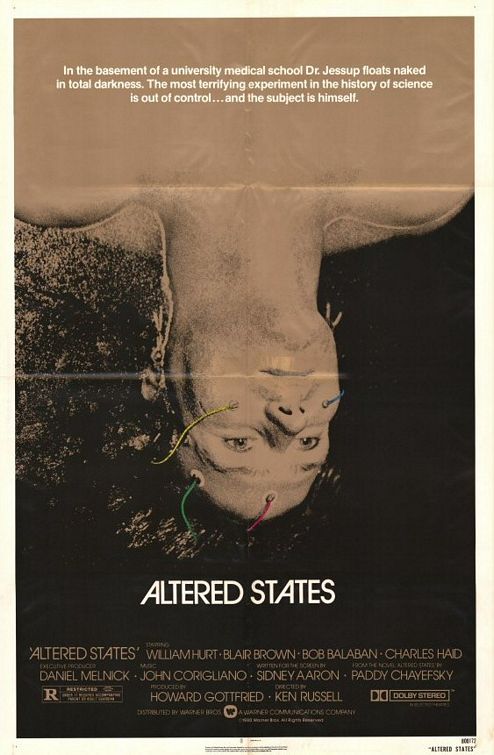Movies Revisited: ALTERED STATES

Altered States is one of those films that I only caught bits and pieces of while I was growing up and never really didn’t pay much attention to it. It is also one of the films that I always passed by in the video store but never took the time to rent, I always said maybe next time. Well, now that I got Netflix it popped up in my movie recommendation tab so I finally watched it from start to finish.
This movie was freakin nuts! I didn’t even remember half of the stuff that I saw through the years until I watched it again in its entirety. If you don’t already know Altered States is a 1980 science fiction film adaptation of a novel by playwright and screenwriter Paddy Chayefsky. Both the novel and the film are based on John C. Lilly's sensory deprivation research conducted in isolation tanks under the influence of psychoactive drugs like ketamine and LSD.
The film was directed by Ken Russell and was William Hurt’s first starring role. It also starred Blair Brown (as Emily Jessup), Charles Haid and Bob Balaban. It also featured the film debut of Drew Barrymore.
Here is he story summary of the film which contains some plot spoilers, but you should read ahead anyway.
The main character Edward Jessup played by Hurt is a university professor of abnormal psychology who, while studying schizophrenia, begins to think that "our other states of consciousness are as real as our waking states." Jessup begins experimenting with sensory-deprivation using a flotation tank, and he travels to Mexico to participate in a fictionalized amanita muscaria ceremony where he experiences insanely bizarre, intense, paradigm-shifting imagery. The professor then returns to the U.S. with the shroom mix he took in Mexico and begins taking it orally before each session in the flotation tank because that is the smartest thing a supposedly smart person should do. He undergoes a series of increasingly drastic psychological and physical transformations. That’s right his wicked jacked up mind experiments lead him down a path of actual, physical biological devolution. At one stage he emerges from the isolation tank as a feral and curiously small statured, light skinned Primitive Man. In a subsequent experiment he is regressed into a mostly amorphous mass of conscious, primordial matter. It is only the physical intervention of his wife Emily which brings him back from this latter, shocking transformation in which he seems poised on the brink of becoming a non-physical form of proto-consciousness and possibly disappearing from our version of reality altogether. It takes going through all this crap that he finally begins to act like someone who values his humanity more than the vast, impersonal nothingness that underlies all of existence.
If you have not seen this movie it will be quite an interesting experience for you. I did not expect the movie that I thought it would be. You should check it out one of these days if you have not done so yet. If you have it may be fun to revisit it with a friend that has not seen it yet just to see their reaction.
I went ahead and found some little details about the movie that you may not have heard about that I found pretty cool and interesting. Check em out below.
- Author Paddy Chayefsky disowned this movie. Even though the dialogue in the screenplay was almost verbatim from his novel he reportedly objected to the over the top shouting of his words by the actors.
- Arthur Penn was originally slated to direct but resigned.
- The book was partially based on dolphin researcher John Lilly, who invented the isolation tank, and first started taking drugs while "tanking".
- Director Trademark: [Ken Russell] [snake] the dream sequence
- In his autobiography, director Ken Russell said he tried mushrooms during the making of the film, which resulted in a bad trip.
- In a 1981 interview with the New York Times, Blair Brown said many of the actors and crew tried out the isolation tank. William Hurt actually hallucinated, while Blair Brown found it very peaceful.
- Paddy Chayefsky had not seen the film before he took his name off the credits.
- At one point, Eddie Jessup mentions the work of "Tart, Ornstein and Deikman." This is a reference to Charles Tart, Robert Ornstein and Arthur Deikman, all of whom wrote books about altered states of consciousness, and all of whom have been involved in modern esoteric spiritual movements, such as the Gurdjieff Work.
- Ken Russell has alleged in interviews he was 27th choice for director.
- Some footage of "hell" in the hallucinations are from the movie Dante's Inferno (1935) taken from a dream sequence.
- At about 56 minutes into the film, when Emily returns from Nairobi, there is an airport announcement paging Mr. Daniel Craig.
- One of the few films to be released theatrically with the "Megasound" sound system format. Megasound was a movie theater sound system created by Warner Bros in the early 1980s. It was used to enhance the premiere engagements of a handful of Warner features. Theaters equipped for Megasound had additional speakers mounted on the left, right and rear walls of the auditorium. Selected soundtrack events with lots of low-frequency content (thuds, crashes, explosions, etc) were directed to these speakers at very high volume, creating a visceral effect intended to thrill the audience.
- It was the only novel that Chayefsky ever wrote, as well as his final film.
- The film score was composed by classical composer John Corigliano (with Christopher Keene conducting) and was nominated for an Academy Award. The film also received an Oscar nomination for Sound, losing to The Empire Strikes Back.